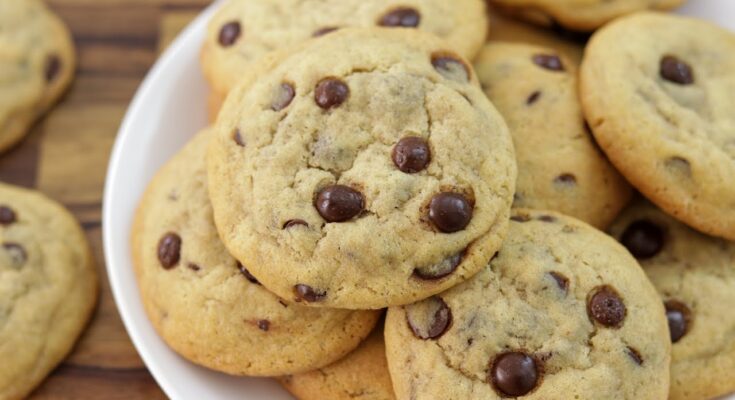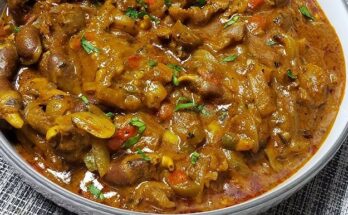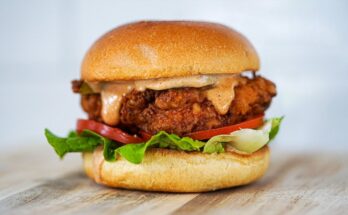Chewy Chocolate Cookies Recipe: There’s something magical about biting into a chewy chocolate cookie—the slightly crisp edge gives way to a soft, gooey center that’s rich, comforting, and utterly irresistible. These chewy chocolate cookies aren’t just your average treat. They’re loaded with deep chocolate flavor, melty pockets of chocolate, and just the right balance of softness and bite.
Whether you’re a beginner baker or a seasoned pro, this step-by-step guide is crafted for you. It’s simple enough to follow, packed with pro tips, and optimized to guarantee you’ll end up with bakery-worthy cookies right at home. So, preheat your oven, roll up your sleeves, and let’s bake the best chewy chocolate cookies you’ve ever tasted!
What Makes Chocolate Cookies Chewy?
Here’s the secret sauce (well, science) behind that mouthwatering chewiness: moisture content, sugar type, and baking time.
A cookie’s texture is heavily influenced by how much moisture stays in during baking. Using brown sugar instead of all white sugar helps hold onto moisture thanks to its molasses content. Room temperature eggs and butter, rather than cold or melted, also help create a creamy base that traps air and moisture.
Overbaking? Big no-no. That’s one of the most common rookie mistakes. Even 1–2 minutes too long in the oven can turn your chewy cookie dreams into crunchy disappointments. Pull the cookies when they look slightly underdone—the residual heat will finish the job.
Another tip? Chill your dough. Not only does this deepen the flavor, but it also prevents spreading, which gives your cookies that thick, chewy center with soft edges.
List of Ingredients You’ll Need
Here’s a breakdown of the essential ingredients to achieve that perfect chewy chocolate cookie texture and taste:
Main Ingredients:
- 1 cup (2 sticks) unsalted butter, softened
- 1 cup light brown sugar, packed
- ½ cup granulated sugar
- 2 large eggs, room temperature
- 2 teaspoons pure vanilla extract
- 2 cups all-purpose flour
- ½ cup unsweetened cocoa powder
- 1 teaspoon baking soda
- ½ teaspoon salt
- 2 cups chocolate chips (semisweet, dark, or milk—your choice!)
Optional Add-Ins:
- 1 cup chopped walnuts or pecans
- 1 teaspoon espresso powder (for deeper flavor)
- 1/2 teaspoon cinnamon for a warm spice kick
Pro Ingredient Tips:
- Use dark brown sugar for even more moisture and deeper flavor.
- If you’re after extra gooey cookies, add an extra egg yolk.
- High-quality chocolate chunks or chopped chocolate bars create those dreamy pools of chocolate.
Essential Baking Tools
Even though this recipe is simple, the right tools can make the process smoother:
Must-Have Tools:
- Mixing bowls (large and medium)
- Electric hand mixer or stand mixer
- Measuring cups and spoons
- Silicone spatula
- Cookie scoop or tablespoon
- Baking sheets
- Parchment paper or silicone baking mats
- Cooling rack
Helpful Alternatives:
- No cookie scoop? Use a standard spoon and your hands to shape the dough.
- No parchment? Lightly grease your baking sheet or use aluminum foil (non-stick side up).
Preparing for Baking
Before diving into mixing and baking, it’s crucial to set up your kitchen for smooth sailing. Think of this step as your mise en place—the French term for “everything in its place.” Prepping ahead not only saves time but also helps avoid mistakes (like forgetting to add the baking soda or discovering your butter is rock solid).
1. Soften Your Butter Properly
Butter should be soft enough to press with your finger but not melted. Cold butter won’t cream properly with sugar, and melted butter will lead to flat, greasy cookies. If you’re in a rush, cut the butter into cubes and let it sit at room temperature for about 30 minutes.
2. Bring Eggs to Room Temperature
Cold eggs can seize up your butter mixture. To speed up the process, place your eggs in a bowl of warm water for 5–10 minutes.
3. Pre-Measure Everything
Measure all your ingredients beforehand. Baking is chemistry, and accuracy matters. Level off flour with a knife and avoid packing it down. Use the spoon-and-sweep method to prevent using too much, which can make cookies dry.
4. Prep Your Baking Sheets
Line them with parchment paper or silicone mats. This ensures even baking and prevents sticking. If you’re reusing baking sheets, let them cool between batches to avoid over-spreading.
Step-by-Step Guide to Make Chewy Chocolate Cookies
Now for the moment you’ve been waiting for—the actual baking! Follow this guide carefully, and you’ll have perfect chewy chocolate cookies every time.
Step 1: Preheat the Oven
Set your oven to 350°F (175°C). Always preheat before you mix the dough. Baking in an unheated oven throws off cooking times and can lead to uneven texture.
Step 2: Mix the Dry Ingredients
In a medium bowl, whisk together:
- 2 cups all-purpose flour
- ½ cup unsweetened cocoa powder
- 1 teaspoon baking soda
- ½ teaspoon salt
Whisking prevents clumping and evenly distributes the leavening agent.
Step 3: Cream the Butter and Sugars
In a large bowl, use a hand mixer or stand mixer to beat:
- 1 cup (2 sticks) softened butter
- 1 cup light brown sugar
- ½ cup granulated sugar
Beat on medium speed for about 2–3 minutes, until light and fluffy. This step is key to creating pockets of air for soft, chewy texture.
Step 4: Add the Eggs and Vanilla
Add the eggs one at a time, mixing well after each. Then, add:
- 2 teaspoons vanilla extract
Mix until fully incorporated. Don’t overbeat—you just want a smooth, creamy mixture.
Step 5: Combine Wet and Dry Mixtures
Slowly add the dry ingredients to the wet mixture, beating on low. Scrape down the sides of the bowl as needed. Stop mixing as soon as there are no streaks of flour. Overmixing can make cookies tough.
Step 6: Add the Chocolate Chips or Chunks
Now the fun part: stir in 2 cups of chocolate chips (or your favorite combo of dark, milk, or semi-sweet). Use a spatula to fold them in gently, ensuring they’re evenly distributed.
Want a gooier bite? Chop up a chocolate bar and toss in chunks. The varying sizes melt differently, adding amazing texture.
Step 7: Chill the Dough
This is a game-changer. Cover the dough and chill it in the refrigerator for at least 30 minutes to 1 hour. Chilling helps:
- Solidify the fat so cookies spread less
- Intensify flavors
- Improve chewy texture
If you’re short on time, 15 minutes in the freezer works too.
Step 8: Shape and Place on Baking Sheet
Use a cookie scoop or tablespoon to form dough balls (about 1.5–2 tablespoons each). Place them on the lined baking sheets, leaving about 2 inches apart for spreading.
For that bakery-style look, press a few extra chocolate chips on top before baking.
Step 9: Bake to Perfection
Bake in the preheated oven for 9–11 minutes. The cookies should look slightly underbaked in the center and set on the edges. Don’t wait for them to look fully done—they’ll continue to cook on the baking sheet after you pull them out.
Pro Tip: Rotate your pan halfway through baking for even results.
Step 10: Cool and Enjoy
Let cookies sit on the baking sheet for 5 minutes, then transfer to a cooling rack. This helps set the structure without overbaking.
Enjoy warm with a cold glass of milk or let them cool completely for chewy perfection in every bite.
Pro Tips for the Best Chewy Cookies
Want to elevate your cookie game? Here’s what seasoned bakers swear by:
- Use more brown sugar than white sugar – it keeps cookies moist.
- Add a little cornstarch (1–2 teaspoons) for softer centers.
- Don’t overmix once the flour goes in – it can develop gluten and toughen the cookies.
- Bake one sheet at a time – this ensures even heat distribution.
- Slightly underbake – trust the process, they finish on the sheet!
How to Store Your Cookies
Chewy cookies need the right storage to stay soft. Here’s how:
- Room Temp: Store in an airtight container with a slice of bread to keep them moist. Lasts 4–5 days.
- Fridge: Not ideal, as it can dry out the cookies.
- Freezer: Yes, please! Freeze baked cookies in a zip-lock bag for up to 3 months.
You can also freeze raw cookie dough balls. Just pop them onto a tray, freeze, then store in a freezer bag. Bake straight from frozen—just add 2 extra minutes to bake time.
How to Reheat Without Losing Texture
Want that fresh-from-the-oven warmth?
Microwave Method:
- Place one cookie on a plate
- Cover with a damp paper towel
- Microwave for 10–15 seconds
Oven Method:
- Preheat oven to 300°F (150°C)
- Place cookies on a tray
- Heat for 3–5 minutes
The oven method gives a slightly crispy edge with a soft middle—almost like they just came out of the oven.
Customizations You Can Try
One of the best things about this chewy chocolate cookie recipe? It’s a fantastic base for endless variations. Once you master the original, go wild with creative tweaks to suit your taste buds or surprise your guests.
Flavor Add-ins:
- Sea salt flakes: Sprinkle a pinch on top before baking for a sweet-and-salty contrast.
- Espresso powder: A teaspoon enhances the chocolate flavor without making it taste like coffee.
- Cinnamon or chili powder: Just a hint can add warmth or spice, perfect for fall or winter.
Mix-In Ideas:
- Nuts: Walnuts, pecans, or macadamia nuts add crunch and flavor depth.
- Toffee bits or caramel chunks: These melt into gooey pockets that take cookies to a whole new level.
- Mini marshmallows: Want a s’mores vibe? Toss in a handful with some crushed graham crackers.
Dietary Modifications:
- Gluten-free: Use a gluten-free all-purpose flour blend with xanthan gum. You won’t even notice the difference if it’s a high-quality mix.
- Vegan: Substitute butter with vegan margarine and use flax eggs (1 tbsp flaxseed meal + 3 tbsp water per egg). Make sure your chocolate chips are dairy-free.
- Low-sugar: Use a sugar substitute like monk fruit sweetener or erythritol. Just be sure to check conversions as they can differ.
Cookies should never be boring. Once you’ve nailed the basic version, you’ll find it’s easy (and fun) to experiment and make it your own.
Troubleshooting Common Cookie Problems
Baking isn’t always smooth sailing. Here are solutions to the most common chewy cookie conundrums:
“Why Are My Cookies Too Flat?”
- Butter was too soft or melted. Try chilling the dough longer.
- Baking sheet was warm. Always use a cool tray for each batch.
- Not enough flour. Double-check your measurements.
“Why Are They Hard Instead of Chewy?”
- Overbaked! Pull them out when they still look soft in the center.
- Not enough brown sugar. It helps retain moisture.
- Cookies cooled too long on a hot pan—transfer to a wire rack ASAP.
“They Spread Too Much!”
- Again, chilling the dough is your best friend.
- Don’t overbeat the butter—incorporating too much air can cause excess spreading.
“They Don’t Spread Enough!”
- Dough may have too much flour. Try spoon-and-level measuring next time.
- Oven might be too cold. Always preheat and use an oven thermometer for accuracy.
Nutrition Information (Estimated Per Cookie)
Please note this is an estimate and will vary based on ingredients and portion size.
| Nutrient | Amount per cookie (approx.) |
|---|---|
| Calories | 180–220 kcal |
| Total Fat | 9–11g |
| Saturated Fat | 5g |
| Carbohydrates | 25–30g |
| Sugars | 18–22g |
| Protein | 2–3g |
| Fiber | 1–2g |
If you’re tracking macros or just curious, you can adjust the recipe to better fit your dietary goals (e.g., lower sugar or higher protein).
Pairing Ideas
Chewy chocolate cookies are delicious on their own, but here’s how to elevate your cookie experience even more.
Drinks That Pair Perfectly:
- Cold Milk: Classic, especially with warm cookies.
- Espresso or Strong Coffee: The bitterness contrasts the sweetness.
- Hot Chocolate: Yes, double chocolate is always a good idea.
- Chai Latte: Spiced tea with a sweet cookie? Heaven.
Serve Alongside:
- Vanilla ice cream: Create your own ice cream sandwich.
- Chocolate mousse: For chocolate lovers who want it all.
- Berries or fruit salad: Adds a refreshing, tart balance.
You can even use these cookies to make crusts for pies or no-bake bars. They’re incredibly versatile!
Why This Recipe Always Works
What sets this chewy chocolate cookie recipe apart from the rest? It’s the perfect balance of flavor, texture, and technique.
- The combination of brown and white sugar delivers sweetness and chew.
- Properly creamed butter and sugar creates airiness without being cakey.
- Chilling the dough makes it easier to handle and prevents flat cookies.
- Just the right bake time leaves you with crispy edges and a soft, fudgy middle.
This recipe has been tested, tweaked, and fine-tuned to ensure delicious results every single time. Whether you’re baking for your kids, a holiday cookie swap, or just because you’re craving something sweet, it delivers every single time.
FAQs about Chewy Chocolate Cookies Recipe
1. Can I use cocoa powder instead of melted chocolate?
Yes! This recipe is designed to use unsweetened cocoa powder, which provides deep flavor without added moisture. No need for melted chocolate.
2. What makes cookies chewy vs. crispy?
It comes down to sugar type (brown for chewy, white for crispy), fat type, and bake time. Chewy cookies are usually underbaked slightly and use more moisture-retaining ingredients.
3. How long can cookie dough stay in the fridge?
Up to 72 hours. In fact, longer chilling can improve flavor and texture. Just be sure it’s wrapped tightly or stored in an airtight container.
4. Can I freeze baked cookies?
Absolutely! Let them cool completely, then store in freezer bags. To enjoy later, reheat in the microwave or oven for fresh-baked taste.
5. How do I know when cookies are done?
Look for slightly golden edges and a soft, puffed center. If they still look a tiny bit underdone, that’s perfect—they’ll finish cooking on the baking sheet.
Conclusion
Making the perfect chewy chocolate cookie isn’t about fancy ingredients or complicated techniques. It’s about understanding the process, using quality ingredients, and trusting your instincts. Once you’ve made these once, you’ll be hooked—and your friends and family will be asking for them again and again.
So go ahead—grab your mixing bowl, preheat that oven, and let the scent of warm, chocolatey goodness fill your kitchen. You deserve it.



